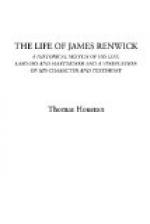No person who peruses these works, and ponders their carefully prepared statements, can with candour and honesty affirm that Renwick and his fellow-sufferers would have willingly incorporated with the Revolution Settlement; or that fellowship with the present British political system, by taking oaths of allegiance and office, and setting up rulers, is consistent with their declared and dearly prized principles. Let the “Plain Reasons” to which we have referred, be duly weighed—and it must be perfectly apparent, that Mr. Dodds’s oracular statement—that the “REVOLUTION SETTLEMENT” was the consummation and triumph, civilly, and politically, and to a large extent ecclesiastically, of the “Fifty years’ Struggle of the Scottish Covenanters,” is completely destitute of any solid foundation. These reasons are such as the following—The Scottish reformation in its purest form was deliberately abandoned in the Revolution Settlement—Both the Church and State concurred in leaving unrepealed on the Statute-book, the infamous Act Rescissory, by which the National Covenants were declared to be unlawful oaths, and all laws and constitutions, ecclesiastical or civil, were annulled, which approved and gave effect to them. The Revolution Church was, in every respect, an entirely different establishment from that of the Second Reformation. Its creed was dictated by Erastian authority—its government established on the ground of popular consent and not of Divine right—its order and discipline were placed in subjection to Erastian civil rulers—and the Scriptural liberties of the ministry and membership interfered with; and corruption in doctrine, and ordinances of worship, without the power of removing it, extensively spread throughout the ecclesiastical body. How sadly different a structure did this appear to the eyes of faithful men, who lamented that the carved work of a Covenanted Sanctuary had been broken down, and the “beautiful House where their fathers worshipped, was laid waste!” Nor could the civil and political part of the Revolution Settlement have any pretensions to be a proper carrying out of the civil system of the Reformation era. In this the federal deeds of the nation were the compact between rulers and ruled, and were an essential part of the oath of the Sovereign on admission to supreme power. Civil rulers were required to be possessed of scriptural and covenant qualifications—and were taken bound to make a chief end of their government the promotion of the divine glory in the advancement of the true reformed religion, and the protection and prosperity of the Reformed Presbyterian Church. They were likewise solemnly engaged to employ their official influence and authority to put away systems that had been abjured in the National vows,—Popery, Prelacy and Erastianism, and to discourage all profaneness and ungodliness. At the Revolution, all these engagements were deliberately set aside. The sovereign’s coronation oath, and the oath of




